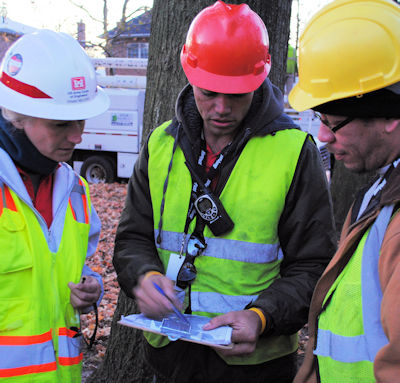Pre-Felling Requirements
31.C.02 Prior to felling operations, the work area must be cleared to permit safe working conditions and an escape route must be planned. Workers must ensure that homes and structures are evacuated where trimming and felling operations are in close proximity.

31.C.03 Felling paths must be at least twice the distance as the height of the tree (due to limbs and debris being thrown after hitting the ground. Where this distance cannot be maintained, limbing may be required. Power lines may also need to be dropped or de-energized.
31.C.04 Each worker must be instructed as to exactly what he is to do. All workers not directly involved in the operation must be kept clear of the work area.
31.C.05 Before starting to cut, the chainsaw operator must be sure of his footing and must clear away brush, fallen trees, and other materials that might interfere with cutting operations.
31.C.06 A notch and backcut must be used in felling trees over 5 in (12.7 cm) in diameter (measured at breast height). No tree must be felled by "slicing" or "ripping" cuts.
- The two cuts that form the notch must meet at a point called the apex, and must not cross that point or go beyond the point where they meet.
- The notch cut used must be a conventional notch, an open-face notch, or a Humboldt notch.
- Notches must be 45 degrees or greater and large enough to guide the fall of the tree or trunk.
- Notch depth should not exceed one-third the diameter of the tree. The hinge width should be 80 percent of the tree's diameter, as measured at the hinge.
- Saw cuts made to form the notch and back cut must leave suitable amounts of hinge wood to adequately control the directional fall of the tree.
- With a conventional notch or Humboldt notch, the back cut must be 1 to 2 in (2.5 to 5 cm) above the apex of the notch to provide an adequate platform to prevent kickback of the tree or trunk. With an open-face notch (greater than 70 degrees), the back cut should be at the same level as the apex of the notch.
31.C.07 If sections of the tree are to be removed, sections must be limited in lengths to one-third of the distance to the nearest structure [e.g. If the tree is 30 ft (9 m) from the structure, sections must be no more than 10 ft (3m)].
Note: The discretion of the chainsaw operator must be used. In some instances it may be safer to fell a large trunk away from the structure rather than to remove it in small sections, especially where the tree has grown very close to the house or structure. If this is done, a tag line must be used to help guide the direction of the fall along with the use of proper notch and backcut.
31.C.08 The chainsaw operator must work from the uphill side whenever possible. Tag lines may be used to help guide the direction of the fall provided the workers on the tag line are well clear of the fall path, such as twice the distance of the fall area.
31.C.09 Just before the tree of limb is ready to fall, an audible warning must be given to all those in the area. All persons must be safely out of range when the tree falls.
31.C.10 If there is danger that the trees being felled may fall in the wrong direction or damage property, wedges, block and tackle, rope, or wire cable (except when an electrical hazard exists) must be used. All limbs must be removed from trees to a height and width sufficient to allow the tree to fall clear of any wires and other objects in the vicinity.
31.C.11 Special precautions must be taken when roping rotten or split trees due to the potential for falling in an unexpected direction even though the cut is made on the proper side.
31.C.12 Persons must be kept back from the butt of a tree that is starting to fall.
Knowledge Check Choose the best answer for the question.
31-7. If a tree is 24 ft (7.3 m) from a structure, what is the maximum length allowed for the sections being removed from the tree?
You forgot to answer the question!
